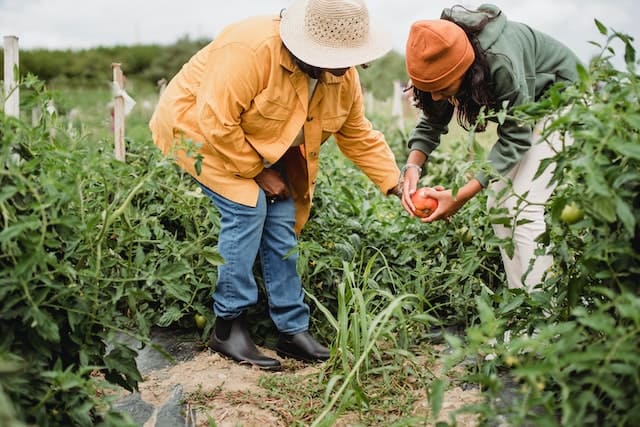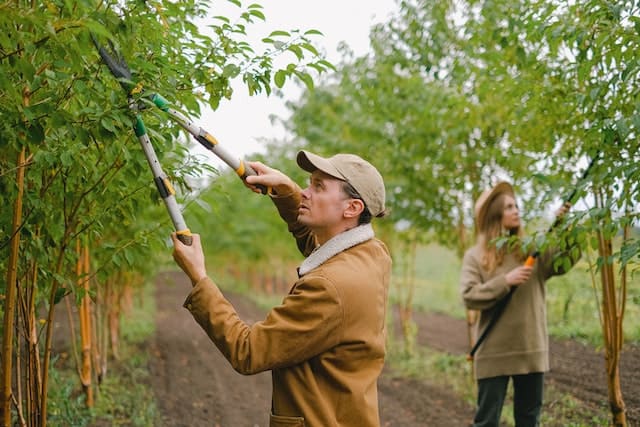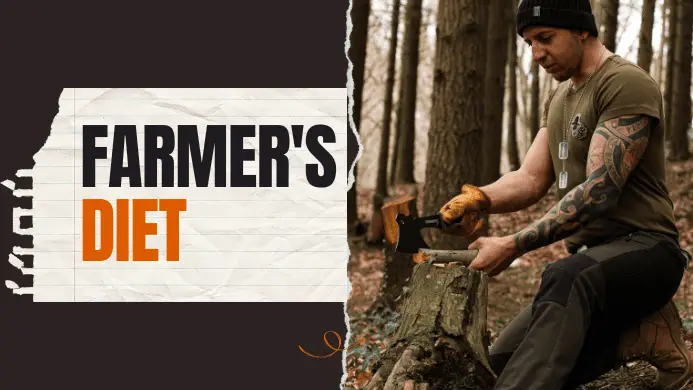Unlike a professional athlete or boxer, a farmer generally doesn’t take measurements on how much protein he/ she consumes per meal. A farmer’s mind corresponds to one thing: eat healthy and fill your stomach and then go outside to do the hard work.
If you stay up close to a real farmer, like I have, you can get a pretty good idea of how much they eat, and also the reason why they’re too strong. Some are even stronger than guys who have been going to the gym for many years.
You May Also Like: Why Are My Calves So Fat? (Diet Or Genetics)
The best diet for farmers is one that is medium in carbohydrates (2 g per kg of body weight), lower in fat (1-2 g per kg of body weight), and high in protein (2 g per kg of body weight). This gives them enough energy to do the heavy and difficult stuff in the field.
Having this macronutrient breakdown is great, but a farmer never counts how much protein his breakfast contains. Read below, and I’m going to show you how to eat and build muscles like a true farmer.
How Many Meals Do Farmers Eat?
Usually, farmers eat 3 meals a day like a normal person. However, most of the time Farmer’s meal depends on the season and workload.
In season time, farmers might skip the meal, which is mostly lunch. Same case, if the workload is more, though he might grab a snack.
Very rarely will a farmer eat more than 3 meals a day.
Sometimes during a season, farmers eat what they are growing as a snack. If a farmer is growing sugarcane or fruits. He might grab one as a snack to save time and get some energy.
Circumstances play a very important role in how many meals a farmer will eat in a day. However, snacks have always been an energy provider for a farmer during a workday.
Not only do farmers skip the meal sometimes but if they have all 3 complete meals the timings can be very irregular.
In season time Farmer might skip lunch. But he might eat more at night. So, the meals and diet plan of a farmer will always be volatile according to the situation and circumstances.
In most cases, farmers eat less in terms of meals than a normal person. But their meals include more protein and nutrition. And extra protein and carbs in their diet are well utilized during the day.
You May Also Like: Emma Chamberlain Workout Routine And Diet Plan
What’s a typical diet Of A Farmer?
There is no such thing as a typical diet of farmers. Farmers’ diets change as the location changes. Moreover, the type of farming is also a major deciding factor here.
If a farmer is doing dairy farming, then there is a high chance that he will consume dairy products more like milk, yogurt, and dishes made of dairy. Where I live many people do dairy farming, so most of the farmers here consume a lot of milk and eat yogurt.
A normal person can not digest that much quantity if the environment and family background are different.
On the other hand, some farmers do fruit and vegetable farming, especially in the California region. So, high probability of farmers eating vegetables and fruits in that region.
You May Also Like: Joey King Workout Routine and Diet Plan
Depending on what farmers have access to is a big deciding factor in the diet of a farmer.
But if we talk generally, most farmers eat eggs, bacon, sausage, oatmeal, cereal, toast, or fruit in their breakfast.
For lunch, most farmers eat rice, salads, leftovers from dinner, granola bars, or yogurt. Where I live yogurt is a must for lunch.
This also depends on the traditional background and what the family used to eat.
If we talk about dinner, then it is the heaviest of all. Usually, now it is recommended to eat less at night for normal people, but for farmers, it is the time to sit and eat with fulfillment.
Farmers work the whole day and most of the work is physical so, the body gets exhausted. Not only do farmers feel hungry after working throughout the day but also it becomes important for them to eat a good and protein-rich diet at night for muscle recovery.
So, for dinner, farmers usually eat meat (beef, chicken, pork, fish), potatoes, vegetables, and sometimes casseroles, soups, or stews.
The amazing thing about a farming family is that they always have herbs in their garden that is outside or back of their house. Farmers love to grow their own food and the things they want.
My grandfather is a farmer and he Wakes up at 5 am. Earlier he used to wake up at 4 am. He used to feed buffalos and cows. Then he used to do different things required in farming.
During the day we used to visit our grandfather in the field with food. Food can be different any day but one common thing is onion.
You May Also Like: Dixie D’Amelio Workout Routine and Diet Plan 2021
You May Also Like: Madison Beer Workout Routine and Diet Plan
Exercises a Farmer Does in His Daily Routine
Being a farmer is all about activity and an active lifestyle. Where nowadays many people go to the gym and do still heavyweight exercises like deadlifts, pull-up bars, bench presses, etc.
Farmers’ daily activity rarely includes any still weight lifting. So, there is a big difference when we talk about exercises included in the farmer’s daily routine

Stretching is very common in a farmer’s life. However it is not a form of any exercise, but it does help farmers to attain flexibility in muscles and also helps in strengthening body parts that are often neglected like the lower back.
Many things that farmers do on a daily basis involves stretching like Picking fruits and vegetables from high branches, gathering eggs from nest
planting seeds, weeding, or caring for low-lying crops involves squatting and bending,
All these types of activity involve stretching, bending, and squatting.
You May Also Like: Addison Rae Workout Routine and Diet Plan
Carrying weights

Carrying weights is not new to farmers, they start doing that as soon as they are kids. This not only makes their body adapt to the activity but also makes them much stronger over the years.
It is all about discipline when it comes to strength and mental toughness.
Carrying hay belle, lifting wood lodges, and feed bags are some works among many that farmers do on a daily basis.
If you know about Brock Lesnar then might know that he is the son of a farmer and he involved himself in farming at a very early age.
He used to carry things at the farm such as carrying hay belle. This not only helped him develop a good core strength but a very strong lower back.
This also helped him in his career as he could easily pick heavy men, you can see that in his early days of school wrestling.
So carrying hay belles and throwing them is one of the best exercises to build your core strength and lower back.
If you want to achieve the same results but you don’t have the environment like Brock Lesnar, then there are alternatives too.
You can use sandbags as a hay belle and carry it. You can also throw them to train your back. Another alternative that you can consider is a medicine ball. You can throw a medicine ball upwards by using the whole body’s strength.
Pushing and pulling weights
Pushing and pulling is a normal form of movement in a farmer’s day-to-day life. If a farmer is doing plant farming then he has to pull seeders, planters, and plows across the fields.
pushing and pulling feed carts, hay bales, or water troughs and pulling equipment for repair are some of the many works that a farmer requires from a farmer.
Chopping wood: 
Many farmers use wood as a source of heat and may chop wood as part of their daily routine. This can help them to strengthen their upper body and core.
Walking
Everyone walks in day-to-day life but a farmer walks more than a normal person. But the walking of a farmer involves carrying pesticides or feeds in their hands.
Sometimes, farmers have to walk uphill while carrying a feed bag. This type of walking not only needs good endurance but also good balancing and strength to carry things while walking uphill.
Why and How are farmers stronger than normal people?
There is a reason why farmers are stronger than average people and mostly it is because they engage in different activities daily.
Another reason is the age they start doing that also matters. Most farmers start farming at a very early age, in their adolescence age.
This helps their muscles and bones to develop and adapt to the activity. This not only builds strength and muscles but also helps them to lift more later in adulthood.
There are many studies that show that children involving themselves in exercise earlier are stronger in their adulthood.
You May Also Like: Jacob Elordi Diet Plan and Workout Routine

Another main reason why farmers are stronger than an average person is because they not only lift weights but also carry them.
Lifting weight is one thing, but carrying it for a specific distance is what builds the farmer’s strength.
Farmers are not limited to a schedule or hit a specific muscle workout. Most of the work in farms involves all body muscles on a daily basis. This makes their body adapt to the activity and environment, which makes them stronger.
If you look closely, farmers don’t limit themselves to a specific activity. They involve themselves in different activities other than farming like fixing tools, hunting, and fishing.
In simple words, they are more inclined towards an active lifestyle. You rarely see a farmer sitting on a couch for a whole day.
Unlike normal people, they don’t have rest days. But that doesn’t mean you should never rest. If you don’t rest after a workout, the results will be completely opposite. Training for a specific muscle or putting pressure on specific muscles in a short time breaks the tissue fiber and to recover that one needs proper rest.
On the other hand, farmers’ activity is more of a whole-body workout. And their workout depends on what they have to do for a day.
Farming is a combination of both endurance and body strength.
Whereas a normal person who goes to a gym plans his day accordingly. If a person is doing a chest workout then there is very little chance of him doing cardio or endurance training.
Normal people plan cardio and endurance on separate days. On the other hand, farmers involve both types of workouts in their daily routine, which helps them carry heavy logs to a distance.










